








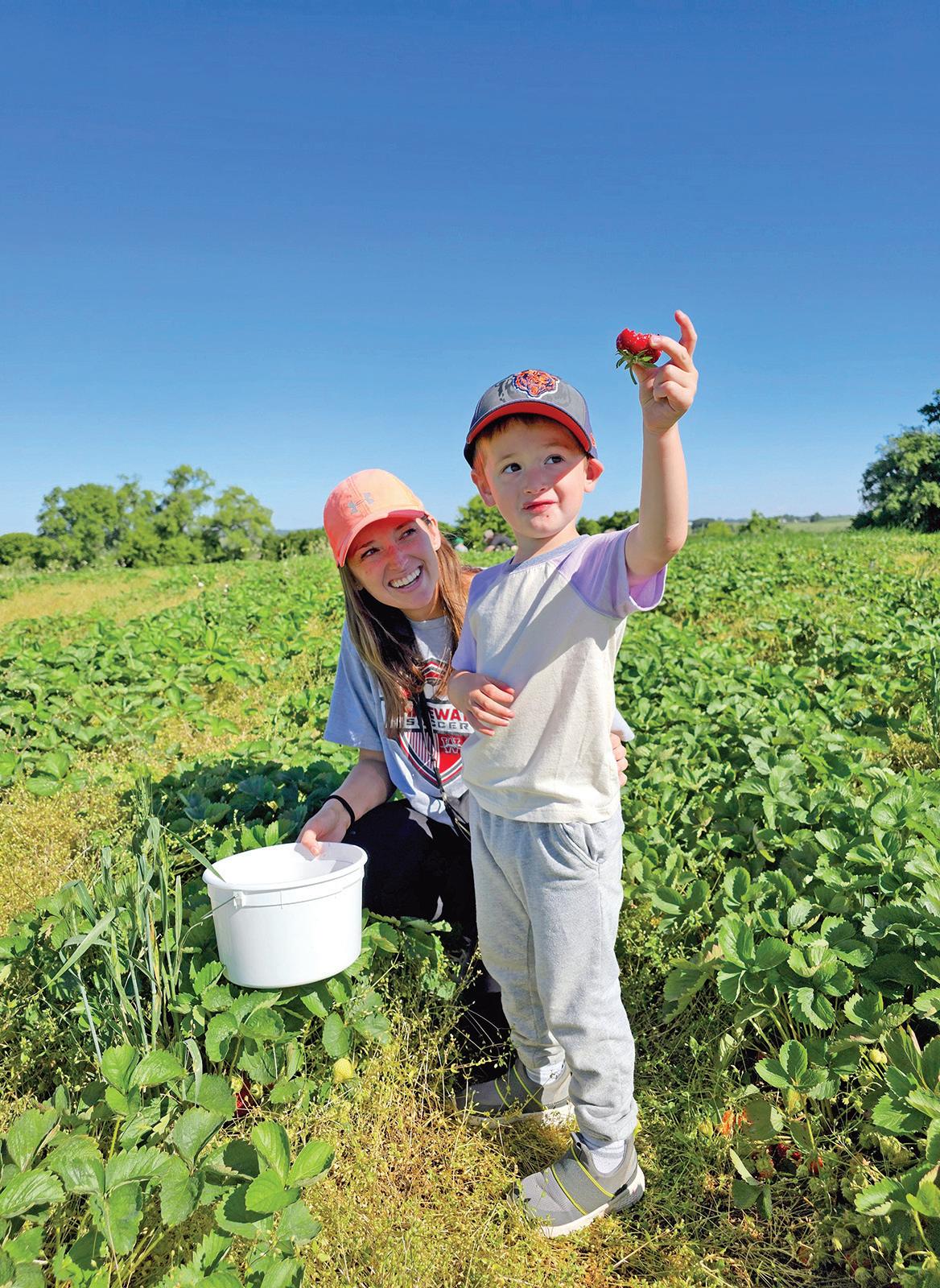
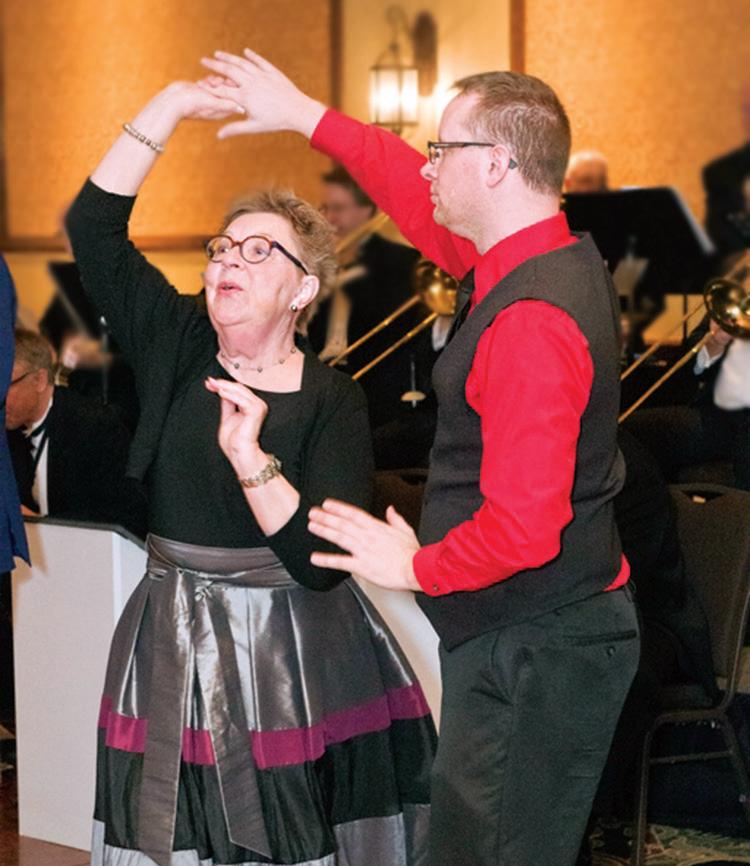

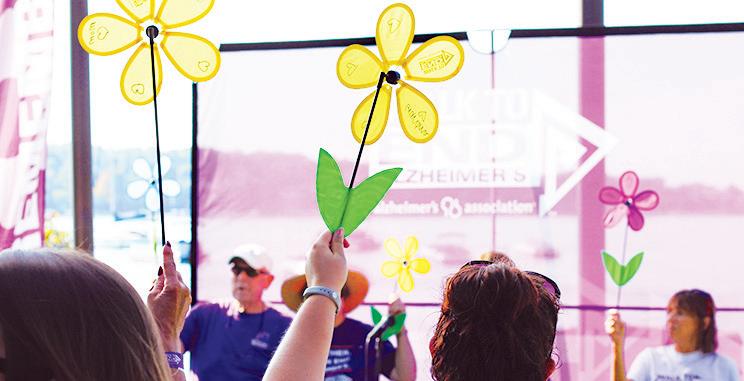










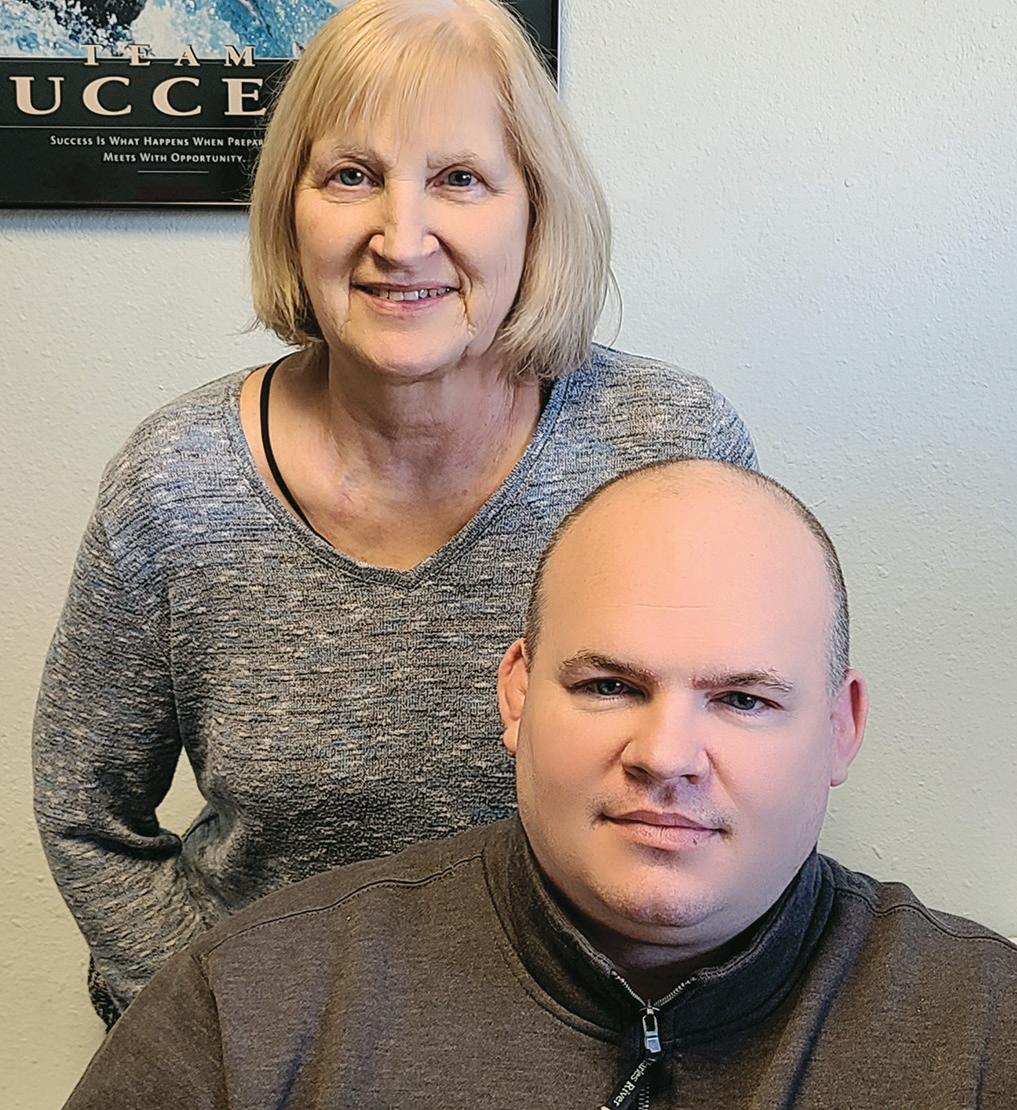
It was the kind of situation only a screenwriter could script.
On day one of the state track and field meet, Bangor Division 3 pole vaulter Sam Crenshaw and Big Foot Division 2 pole vaulter Kaden Rambatt engaged in a backand-forth battle across two different pits.
The next day, Whitewater quietly used four entries to sneak into eighth place in Division 2 – and came close to bringing home three titles.
Oh, and Palmyra-Eagle junior Anna Snorek came within .01 of pulling perhaps the biggest upset of the state meet.
All in all, the WIAA State Track and Field Championships at the University of Wisconsin-La Crosse May 31 and June 1 produced numerous state records across the two days of competition, plus a veritable triumph of medals for Walworth County athletes.
Leading the way was Rambatt, who obliterated the Division 2 pole vault record by two feet.
Rambatt set the new state record a year ago, clearing 15 feet, 2 inches. This year heading into state, he had already cleared 16-3.
But with Division 2 competing on one pole vault pit and Division 3 on the other Friday afternoon – both side by side –Crenshaw and Rambatt put on a show.
Rambatt did not even enter the contest until the bar was raised to 15 feet, 6 inches – when all but one other competitor was out of the competition.
The senior promptly cleared that height on his first attempt, while Mauston’s Eli Hallwood missed on three attempts.
Rambatt had the title – and a new state record – but that wasn’t enough. He then cleared 16-0 and 16-6 on his first attempts, then set up for the height that would be a state record across all three divisions, 17 feet.
Kaden’s father said the weather this year was a challenge, but the two spent time refining technique and waiting for a great weather day.
“We knew at some point he was going to be able to do it,” Dan Rambatt said. “That was his goal this year, to be able to do 17 feet.”
The senior missed on his first two attempts, but took flight on his third, clearing by at least a foot and raising his arms in triumph as he floated into the pit.
Competitors then swarmed him on the mat as Rambatt enjoyed the moment.
“It was just a rush of emotions,” Kaden said. “I think the biggest one was relief.
“It’s the last meet of the season, I was finally able to meet those goals,” he added.
Meanwhile, Crenshaw did much the same for Division 3. He didn’t enter the competition until 14 feet, cleared it on his first try, and then cleared 15-6 on his first try to defeat Ryan Peel of Athens.
Crenshaw needed two attempts to clear both 16 feet and 16-6, but lined up for his attempts at 17 feet at the same time as Kaden, the two exchanging attempts as the crowd watched.
The Bangor senior missed all three attempts at 17 feet, but did have the new state record at 16-6.
“I was rooting for him,” Kaden said. “We were both cheering for each other. The tries for 17 were very close for him.”



taking second.
Then Hefty, Dugan, Quincy Boudreau and Nate Holden switched up the order of the 4x400 relay, which almost paid off in a new school record.
Coach Chad Carstens said the decision was made between sectionals and state to switch up the order, putting Dugan – the fastest runner – first to clear the exchanges of as much traffic as possible at state.
“When you get all those 4x4s together … it’s just this other world,” said Carstens, who added the idea came from assistant Kaptan Wilson and Hall of Fame former coach Mark Maas.
The four runners – seniors Dugan, Boudreau and Holden, plus junior Hefty –bought into the change wholeheartedly.
“As the second leg, I thought of it more as holding the lead, rather than trying to get it,” said Boudreau, who had previously led off.
Dugan, moving from anchor to leadoff, said his biggest worry was potentially false starting on the pistol start versus the open start in the relay.
“Just focus on how you normally do,” Dugan explained was the strategy.
Dugan got the Whippets out to a lead both days, and Boudreau held it to hold off to Hefty.
Hefty, coming off an all-out effort to win the 1,600, did his best in the third leg to hold off Lakeside Lutheran, but dropped back and handed off to Holden in second.
Holden then focused on the clock, intent on getting the Whippets the school record. At the finish, he was passed by Freedom and the Whippets ended up third – but just .05 off the school record.
“I feel like I ran a pretty good race,” Holden said. “That last 100 meters, it’s so tough.”
Lakeside Lutheran, which ended up taking the team title by more than 40 points, ran 3:20.36 to win, while Freedom finished in 3:22.95.
Hefty had perhaps the closest race of the day in the 1,600. Last year, he ran a strategic race and outkicked everyone in the final 400 meters, surprising the field and pulling away on the home stretch.
This year, while Hefty was closer to the front entering the final lap, he had lost the element of surprise. Owen Clark of Lakeland Union hung with him until Hefty kicked on the afterburners.
“It’s always been something I’ve had,” Hefty said of his finishing kick. “I’m normally moving ahead with 300 to go. But Owen’s in front of me, and it’s like, ‘Oh my gosh, we’re racing.’”
Hefty had just enough, winning the title in 4:13.0 to Clark’s 4:13.35. His time was three and a half seconds faster than his winning time a year ago, and close to 10 seconds faster than his seed time.
Kaden went back out for a victory lap, clearing 17-2 on his second attempt before stopping for the day.
“After watching the video, we said, ‘I’ve still got another height in me,’” he said.
“Then I mustered up everything I had.”
Next up for Kaden is the University of Akron, where he will be on scholarship to compete for the track and field team. He made it clear that he wasn’t done clearing amazing heights.
“I’m hoping by the end of college to get 19 feet,” he said. “I’d like to make NCAA
nationals for indoor and outdoor, eventually. Those are big goals. I feel very confident.”
Whippet boys medal four times
While Rambatt and Crenshaw were drawing all the attention on the first day of the Division 2 and 3 meet, the Whitewater boys created a few stirs of their own the second day.
Junior Jack Hefty overcame illness to win his second consecutive Division 2 1,600-meter crown, while Ethan Dugan just missed a state title in the 400-meter dash,
The junior was down in the infield for a while after the race, struggling with the same illness that had been bothering him since mid-season. He fought through it, though, and came back to run the second leg of the 4x400.
Dugan, meanwhile, came in with the top seed in the 400, but knew he’d be in a battle with Osceola senior Addison Uddin.
“I had known his times all season,” Dugan said. “I knew it was kind of going to be between the two of us. For me, it was going and focusing on my own race.”
• Continued on Page 11
If you spend observation time in the Day Services program at VIP Services, you may wonder how many people there are named Bob. Chalk that up to Ryan Schaefer, the manager of Day Services, who enjoys calling people Bob.

It is part of the spirit that Schaefer brings to VIP. His leadership style is easy-going, but still focused.
“When I said three years ago that I was going to do X, Y and Z, there were a lot of smirks,” said Schaefer. “I like that doubt and I work through every aspect to make (the plans) happen. As a person who wants to see change and constant growth, that little bit of doubt acts like a fuel. When I look at it like that, having a little doubt of ‘can I pull this off?’ makes the milestone a little more important.”
He started in June of 2019 as a Day Services program assistant. Schaefer officially became the manager in the spring of 2020. He made changes to the style of how staff interacted with the adults with developmental disabilities.
“As I built the programming, I wanted staff members to be more like mentors, to be part of the program,” said Schaefer.
“I believe anyone and everyone should have the opportunity to try anything they want, within reason,” said Schaefer. “Life is all about experiences. As long as we provide opportunities and experiences in a safe way, go for it!”
Craig Poshepny, executive director
of VIP, likes the direction that Schaefer has taken the Day Services program.
“He’s grown a lot in the last two years to implement his vision,”
Poshepny said about Schaefer, who is the youngest member of the VIP leadership team. “I came in with a vision and it matched (with Schaefer’s).”
Poshepny said it is harder to define what is a success in Day Services.
“It’s not a cut and dried role. (Schaefer) has done a nice job moving the department forward,” said Poshepny. “It is continuous improvement; it’s never perfect, never done, but we continue to improve.”
Schaefer himself has vast experience. He worked as a truck driver, caregiver, security guard, and as a behavioral health specialist/mental health specialist for almost a decade. He has a background in science, focused on psychology. He attended Western Illinois University.
“I’m a ‘Bob’ of all trades,” he quipped.
He married Danielle, who he has been with since 2020, on Dec. 3, 2023. They have a dog, named Polar Bear, who is an English Cream Retriever. Hailing from Elgin, Ill., and growing up near Round Lake, Schaefer and his wife now make Lake Geneva home.
So how did he end up coming to VIP?
“I used to work in a group home where people came to VIP. I knew of it,” he said. “I didn’t want to work third shift anymore, so (I decided) to take a look.”
How does Schaefer describe his style?
“Everything I do or when I say


to the style of how staff interacted with the adults with developmental
SubMitted Photo Wonders of Walworth County
something, there’s a starting point that progresses into something more,” he said. “I design the program in the best interests of individual people. You get that interest. If you try to rush doing it, it would’ve failed.
“It will take a little while to get there, but it will be beyond anything that could’ve been imagined... It’s already on a fast track. I can only do so much; I can’t do it by myself,” he added.
That is where he leans on his staff. Schaefer doesn’t push staffers to do what they are not comfortable doing.
“I don’t like gardening, so I don’t do it,” he explained. “Someone else can have that opportunity. It is more about laying out a roadmap. Truth be told, at this point, I think we are ahead of schedule. Will that stop me from putting my foot on the gas? Absolutely not. I’m fueled by, ‘Can you top this?’”
He said he thinks of things with what is a plus or a minus and how people can be motivated.
“Every little thing comes back to my mindset, ‘How do I top it?’ I want to be
me,” Schaefer said. “I don’t do things conventionally. I get more satisfaction out of someone else’s satisfaction and joy.”
He said the work in VIP Day Services is all about being a team. He looks for the strengths of each person. In no way, he said, is he going to put someone in an unsafe situation. He doesn’t want his staff to do things they are uncomfortable doing.
“A little bit of me started showing up in all that we’re doing,” said Schaefer. “We’re riding with it. It can’t get stale if you believe in everything you do. It’s no longer working; it’s coming here, having fun, giving people opportunities. That can’t get stale.”
Yessiree, Bob.
Editor’s note: This is from a series of articles featuring the leadership team in Day Services at VIP Services, Inc., in Elkhorn. Keep an eye on VIP’s Facebook page and YouTube channel for videos that document Day Services adventures. For more information including those interested in becoming part of the Day Services program, contact VIP at 262-723-4043 or vip@vipservices-inc.org.
Residents and visitors alike can spend time this summer in an activity unique to this area – a walk along the Geneva Lake Shore Path. The popular walking trail travels around the entire lake, roughly 26 miles in all. But there are several areas to enter the path, which offers flexibility in the length of a hike.
The history of the path goes back to the days of the Indigenous people of several Native American tribes, who made their home in this area, including the Potawatomi led by Chief Big Foot.
A plaque placed in Library Park on the shore in Lake Geneva gives a short history of this trail that began many centuries ago.
“The 26-mile lakeside trail along the shore of Geneva Lake was used by several Indian cultures from 2500 BC and continuing to 1836 A.D. Chief Big Foot’s Potawatomi tribe walked the trail between their villages at present Fontana, Williams Bay, and one at Lake Geneva located in this park. Later the trail became the workmen’s path from Lake Geneva to the summer estates of wealthy Chicago families,” it reads.
These wealthy Chicagoans made their way to the shores of Geneva Lake after the Chicago Fire of 1871, remember the one that was said to be started by Mrs. O’Leary’s cow? At that time the citizens of Chicago looked for an escape for their families, away from the smoke and polluted air of the city as it was rebuilt.
It was to Geneva Lake that they traveled, where they found the perfect setting to build summer cottages. But unlike the summer cottages most would envision, theirs were actually mansions, large and elegant, much as their homes in Chicago.
Wives and children would come to the lake for the summer, with their servants, while the husbands would commute up on weekends as they continued to work during the week.
Many of these lavish homes can still be found on the shores of Geneva Lake, and a view of them can be enjoyed while in a boat on the lake or walking the shore path.
Over the years many of these lavish homes have been torn down and the
properties divided into smaller parcels with new buildings. While some may be less impressive than the originals depending on who you ask, they are generally still a gorgeous sight from the shore.
It was the early settlers who deemed that the “20 feet leading to the shoreline be preserved as public domain.”
The plan was to keep this historical path for future use in memory of the past and to assure that the lakefront would remain available for all to enjoy. Each property owner is still required to maintain the path through their property, which has made each section of the path unique.
Just as each estate itself has a different look, the shore path offers many different looks as walkers move from one property to the next.
Not all property owners were pleased to have strangers walking through their property and some tried to discourage visitors from traveling across by making the section of trail on their property challenging, from a narrow path to one overgrown.
In 1970, the owners of Stone Manor at the time were sued by the City of Lake Geneva for constructing a fence that blocked the shore path. The city won, the fence came down and the path remained intact.
While walking the entire path in one day is possible for those in good health who walk regularly, it takes eight to 10 hours to complete. For those not ready to tackle the entire trek around the lake, dividing it into sections will make it easier to navigate yet still offer a variety of things to see along the way.
Public access points – where walkers can join or leave the path – must be used. Cutting through owners’ lawns is not acceptable, nor is sitting on the piers or chairs or benches on the individual properties. Only the actual path is open to walkers.
For those who wish to tackle the shore path in shorter stretches, access points are in Lake Geneva, Fontana, Williams Bay, Linn and Big Foot Beach. Each one of the



sections – whether walking along the path and turning around to return to the access point used as the entrance or walking to the next public access point – are a good hike with incredible views. Those wishing to walk from one access point to the next should team up with a friend so one vehicle can be left at the area where the walkers will exit the path and the other vehicle is used to drive to where the path will be entered.
The path is family friendly, but those with younger children should start by taking a shorter walk along the path – familiarizing themselves and children with the challenges of hiking before tackling a lengthier stretch.
The walk from Lake Geneva to Williams Bay is about 7 miles, while a shorter walk from Williams Bay to Fontana covers about 3.5 miles.
Dogs must remain on a leash and under control the entire time while on the path. Walkers must clean up after the dog and remove the waste from the area.
There are no public access garbage bins so anything brought along must leave with those using the path.
The shore path is a walking path and not made for bikes, scooters, strollers, or wagons. With surfaces that vary but include cement, bricks, wood planks, gravel, steppingstones and narrowing in areas, it’s not practical for much more than peoples’ feet to be on the path. Wearing comfortable walking shoes with non-skid treads is recommended for safety especially when the path is wet and slippery.
Safety is important as some areas of the path are very close to the water and may not have a fence separating walkers from an unexpected dip in the lake. For those with young children, it’s recommended they walk from Library Park in Lake Geneva – in either direction.
On the other hand, for those who plan to walk the entire path in one day, it’s suggested they start at the south end of the lake as that section is more difficult and is best attempted when you aren’t tired.





What started out as a backyard school has turned into a movement for a small but passionate group of people who believe that our culture has become too disconnected from nature, and that our exposure and experiences with the natural world are an essential part of our growth.
Jodie Janovec, Erin Houlihan, and Anna Zinga are the co-directors of Humble Oak Outdoor Learning & Arts Collective in East Troy. The outdoor-based educational program is made up of two branches – a Living School, and a Folk School – and serves both children and adults.
While enrollment for the non-profit began as a start up in 2022, the idea for the learning center formed in all three women’s hearts long before that time.
Erin ran a small backyard program called Violet Glen that Anna helped with and Jodie’s children attended. It grew into a dream to be able to have the space to welcome more children, and to nurture those children into adulthood and beyond.
Along with teaching at Violet Glen, Anna taught middle school and said she believed the kids needed something more than was able to be provided in a public school setting.
“Working at Violet Glen, it was so easy to see how the kids thrived when their days were spent in nature,” she said. “I wanted to be able to give that to as many kids as possible.”
During the Covid-19 pandemic, when the world was shut down and so many parents were struggling to help their children through the unprecedented crisis, Jodie said she knew they could make those community connections happen.
“We started to explode with requests to join during that time. Erin taught my youngest when he was in preschool, Anna had a background in education, too, and we all had a passion for incorporating daily learning into the practice of mindful living, so it felt like it was meant to be,” she said.
An ideal place to grow
Finding land where they could carry out their vision was crucial. They approached Living Lands Land Trust, which had an 80-acre lot in East Troy. They were looking for someone to help them steward the land.
“It happened totally organically,” Anna said. “The land is an important piece to us, and we all have a connection to it.”
In exchange for use of the land, Humble Oak helps take care of the woods, clear the trails, and assists with conservation work, when needed.

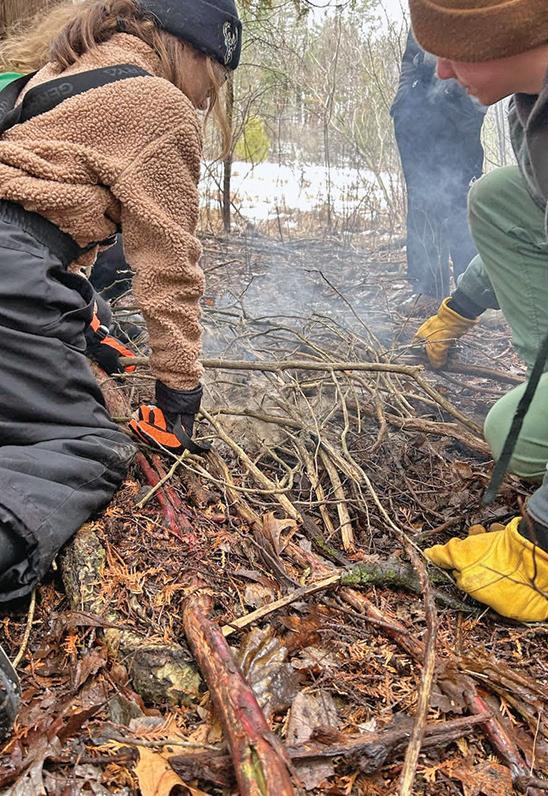
humble oak outdoor learning and arts Collective has two branches – a living School (9-month program and summer camps for children 3 to 16) and a Folk School (which provides weekend classes and workshops for adults and youth, taught by a diverse group of artists and craftspeople serving as instructors, including dan o’leary, of honey Valley beekeeping.) in an introductory to Spinning class, kora adam (left) and Mo Storey (front) are learning to use prepared wool roving and a top whorl spindle – by putting the spindle in motion, it will draft the firber to create yarn. Classes suited for outside learning are held at the Woods, while other classes are held at the honey Creek Collective – both in east troy.
The Living School consists of three groups: Squirrels (ages 3-6), Beavers (7-10), and Hawks (11 -14).
Students focus on engaging in nature through play, and learning in ways that suit their age and capabilities while also being activities that correlate with the seasons.
Younger students sing, explore and learn through crafting and activities that help them grow in confidence. Following the seasonal program as the students age, older ones have the opportunity to express their natural gifts while learning skills and crafts that ground them to the earth and remind them of their role in it.

They began with the Living School, also known as a Forest School, for children 3 to 14 years old in the fall of and have added summer programs for children 4 to 16 years of age.
The trio of co-directors said they’ve had countless supporters along the way –especially in the beginning when they were hoping to fill the Living School with enough students.
“When we need something, it just seems to appear and I think a lot of that is just having that trust and belief that if we keep moving forward good things will happen,” Jodie said.
“We believe that our well being is directly related to how close we are to nature,” Anna said. “Not just as children, but throughout our whole lives.”
That’s why the goal of the Humble Oak Outdoor Learning & Arts Collective is to open a space where people of all ages can have the opportunity to deepen their knowledge and understanding of the natural world, and hopefully more people will come to a greater understanding of how we’re connected to it, and how important that connection is.
The Folk School was born from that belief along with the knowledge that learning never ends.
“We have it set up where a person can grow and evolve throughout their whole

life,” Jodie said.
The classes are presented by instructors, most of whom are local, who aim to “empower the community to craft, move, and interact with fellow beings in ways that are in harmony with the reciprocal energy of life on Earth.”
Many of the classes are held at the Honey Creek Collective, a space in East Troy that brings together a wide variety of wellness practitioners.
Focused on those from 16 years old to adult, the Folk School offers a wide variety of classes from woodcarving, beekeeping, fiber arts and spinning, to field botany, mushroom foraging and ceramics.
In a recent farm-to-yarn immersion course, students were able to go to a local farm, learn how to shear sheep, then go back

to Honey Creek Collective and learn the art of spinning it into yarn.
The students aren’t just learning valuable skills, either. Many of them are also finding a deeper meaning at the same time.
“We’ve seen how much people crave this kind of connectedness,” Anna said. “We’re all connected… and to have experiences where we witness that, and learn from it, is powerful.”
One of Humble Oak’s core beliefs is to remember where we came from, which is how the group’s name evolved.
“We always want to remain humble in what we’re doing.” Jodie said. “There’s a
• Continued on Page 9

Derrick Funeral Home will be more than honored to assist you or your family with everything from a traditional funeral to celebration of life to preplanning and pre-funding a funeral service. If you have any questions please don’t hesitate to give us a call, 262-248-2031 or visit our website, www.derrickfuneralhome.com for more information.
Since our first location in 1912 in downtown Lake Geneva, the Derrick Funeral Home has been owned and operated by the Derrick family.
Even though we have moved to a couple of locations, one thing has remained the same, the professionalism and the dedication of the staff to providing the families that we serve with the best possible care.


Katie Holcomb’s career path didn’t actually start with her wanting to be a farrier.
“Actually, it wasn’t my original plan,” said Holcomb, who went to college for civil engineering.
While in school, she said she worked at We Energies for a bit, and discovered sitting behind a desk wasn’t her thing.
“I really wanted to do something with horses,” Holcomb said. “It kind of just stuck.”
Holcomb owns and operates KT Horseshoeing LLC. While she has an actual physical address at W5558 Briarwood Road in Elkhorn, she spends most of her time on the road working with horses both large and small.
It’s not just the work of shoeing a horse. It’s also trimming hooves and corrective work if needed.
“My favorites are when I have a really bad case and I can see the progress and the improvement,” Holcomb said. “Sometimes even right away.”
A farrier is described as a craftsman who trims and shoes horses’ hooves. Holcomb attended and graduated from Oklahoma State’s horseshoeing school, and she’s worked in both Oklahoma and Texas.
Now, her typical day is roaming around the southeast Wisconsin area, working with multiple horses, even more than one at some appointments.
Part of the magic, she said, is getting a horse to stand and work with a farrier to have a hoof lifted so the person can trim or shoe the animal.
“It is weird for horses, since they are flight animals,” she explained. “There are
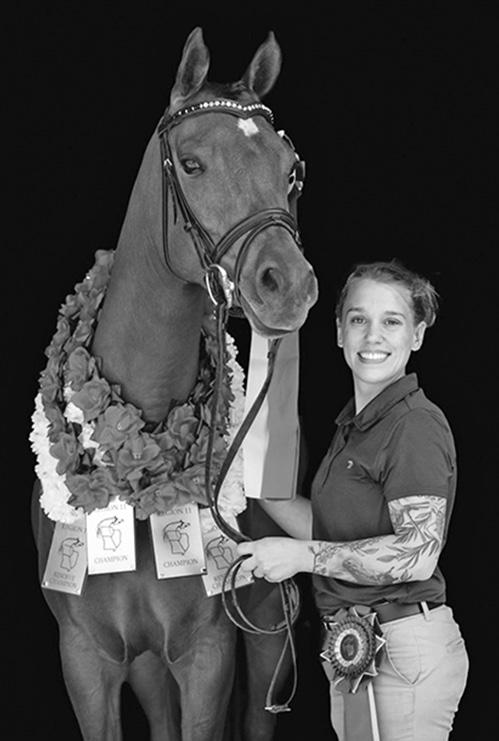
SubMitted Photo Wonders of Walworth County
definitely some times where they are not so good.”
Holcomb said horses should be trimmed every six to eight weeks. When they get beyond that, it is more likely a horse will be sore after the trimming, or it will be harder to get a shoe onto the horse.
She said people can consider trimming the toenails on their horses.
“A lot of people like to say, ‘no hoof, no
horse,’” she said. “If their feet are bad, a lot of times horses will be put down.”
In addition to regular trimming, Holcomb works with horses that need corrective work. That can include the anatomy of a horse being incorrect, which leads to a condition called founder.
It’s a condition Holcomb says crops up most often with ponies. Since ponies have different nutrition needs, an incorrect diet can lead to laminitis – an inflammation of the foot.
That, in turn, can lead to founder, where the bone turns downward. The hoof then grows a lot of both heel and toe.
“It creates that slipper look,” Holcomb said of the horses’ hoof.
As a farrier, Holcomb explained that she’ll shorten up the trim cycle and take off as much of the hoof as possible. It is a case-by-case basis on whether it will be an isolated case with a horse or become chronic.
“Those ones, you can immediately see the major difference, in one trim,” she said. “To actually make it look like a foot again.”
While the job is labor intensive –Holcomb is either driving or trimming hooves – it is fulfilling work.
“I just love to help animals,” Holcomb said. “When I see a horse that’s not doing so well and I can turn that around in a visit or two, that’s what makes a lot of it fulfilling…like I did something.”
While Holcomb is generally booked out about 3-4 weeks this time of year, she is still accepting new customers.
To contact Katie Holcomb of KT Horseshoeing, call 262-758-9400 or email Holcomb at kthorseshoeingllc@hotmail. com.

Walking the path is a memorable experience but what time of year its best enjoyed is a matter of preference.
Some prefer spring with its sense of new life as flowers and greenery begin to show their colors. Summer generally features nearly everything along the path in full bloom. Then there is autumn, with its myriad of colors as the leaves show off their shades of red, orange, yellow, and brown, as well as fall flowers on display around the lake.
Regular shore path walkers will head out during all three seasons as each offers a different view of the path and sights along it but also of the lake.
The path is accessible during the winter but only experienced walkers with proper shoes and equipment should consider it that time of the year, considering the path is not shoveled and is often icy and slippery.
Also in the winter months, some of the piers may be stored in a manner blocking the path, possibly making passage impossible.
For safety – as mentioned before –good sturdy walking shoes are important, and on sunny days, portions of the path are out in full sun so remember to wear sunscreen and a hat to protect against sunburn.
There are no restrooms or food stands on the path. Restrooms are available in public areas such as near the library in Lake Geneva, Williams Bay and Fontana. Carry water or other liquids with you to avoid dehydration.
Dogs must remain on a leash and under control the entire time while on the path. Walkers must clean up after the dog and remove the waste from the area. There are no public access garbage bins so whatever you bring in must leave with you.
• Continued FRoM Page 7
beautiful, huge grandmother oak tree on the property. We call her Humble Oak and we walk by her every day with the kids and bring her little gifts.”
More than a year ago, when the trio was working to decide where they would host their programs, Erin spent time walking in the woods carrying that very question with her. On one of those walks she remembers that it felt like the woods were reaching out.
“I had a strong sense that they were waiting for the invitation to be of service and share their healing gifts with us,” she said.
Erin said she believes that this relationship with nature is mutual, and when all of us are given the room to let our own nature unfurl and exist as we are meant to, we resemble the woods.
Ultimately, that is what Humble Oak hopes for those who step into their space and learn from their instructors – that what is intrinsic in us comes to life when we make a connection with the earth, and that we use it to bring healing to the communities around us.
“Having an authentic, intimate relationship with the woods invites us to retain and integrate our full capacities and responsibilities as Humans in our Earth community. This practice and understanding is essential for us all at this time,” Erin said.
For more information about Humble Oak, including classes offered, visit the website at humbleoak.org.









During finals, Dugan said he was focused on going out faster after a slow start in prelims. But by the time he got to the home stretch, Uddin was pulling away, winning in 47.73.
Dugan, meanwhile, broke his own school record by running a 48.61.
“I can’t be mad about running my bestever time,” Dugan said.
Whitewater’s other medal came from another junior, Traysen Thomason. While the focus going into the boys Division 2 meet was on the speediness of Campbellsport’s Josh Onwunili, Thomason said he was thinking, “do my own thing.” Thomason got out to a great start in the final, “and then I got caught, which I kind of expected.”
Onwunili, who had been waiting for a WIAA exception to even compete in regionals, won in 10.70 (and added the title in the 200 as well).
Ben Krauklis and Marvanous ButlerBrown – who defeated Thomason at sectionals – finished second and third in 10.95 and 11.08, but Thomason took fourth in 11.14.
After coming into the season with few expectations, Thomason said he was thrilled to finish state with a medal.
“I’m thinking that, since I’m in a really good spot right now, I’m hoping to get faster and faster,” Thomason said. “Hopefully, I can win it next year.”
Both Hefty and Dugan earned All-State honors by being among the fastest six times or distances across all divisions.
Palmyra-Eagle junior Anna Snorek enjoyed a strong spring track season, setting a new school record in the 200-meter dash in 25.79 and helping the Panthers to a new school record in the 4x200 and 4x400 relays.
Both relays as well as Snorek were at state over the two days. The two relays just missed finals, finishing 11th with 10 schools qualifying.
The 4x200 relay of Tayler Harbison, Snorek, Chloe Warner and Lainey Fredrick were just off their school record in 1:48.03.
The 4x400 relay, meanwhile, set another school record, with Snorek, Dora Bothe, Warner and Fredrick crossing in 4:10.48.
That left Snorek as the only runner in finals, as she qualified ninth in the 200 and would be running from lane 1.
“We actually went out Saturday morning,” Palmyra-Eagle coach Derek Reeves said. “We went down and went over a couple of strategies … getting a good jump start on it, get a good lead.”
Reeves said Snorek then sat back and watched the rest of the races – and tried to relax.
“The pressure wasn’t on her,” Reeves said. “She was able to focus on her race. Everything was kind of free at that point.”
In spite of the tight turn, though, Snorek caught an incredible start and was neckand-neck with favorite Bella Thomas of Wisconsin Rapids Assumption.
At the tape, Thomas just outleaned Snorek, 25.42 to 25.43. However, Snorek’s time was a new school record by .36.
“We knew she was capable of running a really fast time,” Reeves said. “Finally, it all clicked to come together at the right time.
“I don’t think anyone knew who actually won until they looked at the board,” he added. “She was overjoyed.”
Snorek had previous experience at state, running on a medal-winning 4x100 relay as a freshman (the Panthers took sixth) and ran in the 100 last year.
As a whole, the Panthers exceeded expectations, setting school records in both the relays as well as Snorek’s race.
“We had the ability to go out and have that experience,” Reeves said. “Ultimately, we would’ve loved to have made the finals in both. Overall, I couldn’t have asked for a better outcome.”
After qualifying in two events last year, Delavan-Darien junior Addison Stallings entered state with three events on her agenda – the 100 hurdles, the 300 hurdles and the triple jump.
On day one of the meet, Stallings bowed out of the 100 hurdles, finishing 15th in a solid time of 16.34.
But Stallings did make the final of the 300 hurdles, qualifying fifth.
She competed in the triple jump first on Saturday, putting together a leap close to her season best and reaching 35-2.25. She won a tiebreaker to earn the sixth-place medal.
Taking the track after for the 300 hurdles, Stallings looked to have another medal locked up, but stumbled coming over the final hurdle and falling flat-out on the track.
She got up and finished the race, but took eighth in 49.40. The race was marred by falls and a disqualification for a false start.
Delavan-Darien had one other entry at state, as the 4x400 relay of Sophia Szczap, Alaina Sorg, Delaney Stallings and Katelyn Stearns took 14th in 4:12.62.
Coach Bill Stallings praised the relay team, which broke the school record yet again.
“Breaking the school record is an awesome accomplishment at any meet,” he said. “But to do it at the state meet, it says a lot about those kids and the toughness that they have.”
He also praised Addison, who “did not have the meet she was hoping for.”
“Still, to make state in four events (she was the alternate on the relay) and medal in one, she should be really proud of her season and all that she accomplished,” he added. “The 300s were especially heartbreaking for Addy. Unfortunately,
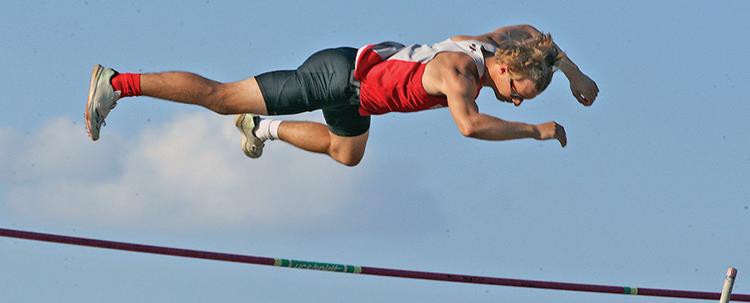

it didn’t work out. She will use this experience and learn from it and become better.
“That’s who she is,” he added. “She’s a fighter.”
Other entries at state included:
• East Troy’s Division 2 girls 4x200 relay finished second for the second straight year, with Lillian Swanson, Aubrie Cherek, Valencia Burgos and Amya Pluess coming across in 1:44.44; 4x100 relay of Swanson, Jillian Pergande, Cherek and Pluess just missed finals, taking 11th in 50.51; 4x400 relay just missed the podium, with Cherek, Pluess, Swanson and Burgos taking seventh in 4:00.31; Pluess was ninth in the long
jump (17 feet even); Haelyn Houston was 13th in the girls Div. 2 discus throw (107-4).
• The Big Foot girls Division 2 4x100 relay of Elliana Pape, Allie Stankevitz, Lydia Farence and Ava Schoonover, which suffered a bad handoff and was disqualified.
• The Whitewater girls Division 2 4x200 relay of A’lani Ross, Sydney Schilt, Calli Grosinske and Athena Soto, which was 15th in 1:49.02.
• Elkhorn’s Division 1 girls 4x200 relay of Takiyah Bolton, Kaylee Frank, Laura Hensel and Addie Baker, 19th in 1:46.44; Jenna Heindselman, who cleared 5-0 in the Division 1 high jump and finished 17th; EAHS boys Division 1 4x400 relay of Cayden Burns, Owen Backus, Trenton Eby and Tre Truesdale were 18th in 3:28.52.

